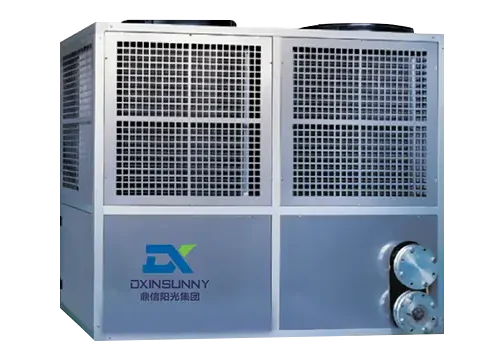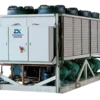Core Advantages

Energy Efficiency and Environmental Friendliness
- Low-temperature air source heat pumps are highly energy-efficient. They can extract heat from the air even in cold temperatures, using significantly less electricity than traditional heating methods. This reduces energy consumption and lowers operating costs. Moreover, they are environmentally friendly as they do not burn fossil fuels, resulting in reduced greenhouse gas emissions and a smaller carbon footprint.
Versatility and Reliability
- These heat pumps are versatile in their applications. They can provide both heating and cooling, making them suitable for year-round use. Their compact design allows for easy installation in a variety of locations, including homes, businesses, and industrial settings. Additionally, they operate quietly and are known for their reliability, with fewer moving parts and lower maintenance requirements compared to traditional heating and cooling systems.

Energy Efficiency

Environmentally Friendly

Wide Applicability

High efficiency and low noise

Space Saving

Long Lifespan and Reliability

Energy Efficiency
- It can convert a large amount of low-temperature heat energy in the air into useful heat, with high energy conversion efficiency. This significantly reduces energy consumption and operating costs compared to traditional heating methods. For example, it can achieve several times the energy efficiency of electric resistance heating.
Environmentally Friendly:
- It does not emit pollutants or greenhouse gases during operation, helping to protect the environment. It is a clean and sustainable heating and cooling solution.


Wide Applicability:
- It can operate effectively in low-temperature environments, making it suitable for use in various regions and climates. Whether in cold northern areas or milder southern regions, it can provide reliable heating and cooling.
Efficient and low-noise operation
- Noise reduction technology is used to ensure that the device maintains a low noise state during operation, creating a quiet living and working environment for users.
- It maintains silent mode while operating efficiently, suitable for installation in bedrooms or office areas, without interfering with daily activities.


Space Saving:
- Due to its compact design, it takes up less space compared to traditional boilers or air conditioning units. It can be installed outdoors or in a small indoor space, freeing up valuable indoor area.
Long Lifespan and Reliability:
- With proper maintenance, low-temperature air source heat pumps can have a long service life. They are built with durable materials and advanced technology, ensuring reliable operation for many years.

Product Specifications
| Product Specification | Details | Product Specification | Details |
| Heating Power | 6.0 kW | Energy Efficiency Rating | A++ |
| Refrigerant Type | R410A | Applicable Area | 50-150㎡ |
| Power Supply Voltage | 220V / 50Hz | Noise Level | ≤25 dB |
| Dual Inverter Technology | Supported | Smart Temperature Control | Supported |
| Remote Control | Mobile App Remote Control | Auto Defrost Function | Supported |
| Operating Temp Range | -15℃ to 45℃ | Weight | 40 kg |
| Dimensions (L x W x H) | 850mm x 300mm x 650mm | Installation Method | Ceiling / Wall Mounted |
low-temperature air source heat pump unit Feature and Application:
Application:

Industrial Processes:
Can be used in some industrial applications where low-temperature heat is required. For instance, in certain manufacturing processes that need a constant temperature environment, the heat pump can provide a reliable heat source.

Commercial Buildings:
Suitable for offices, shops, restaurants, and other commercial spaces. It can meet the heating and cooling needs of these buildings while reducing energy consumption and operating costs. In a shopping mall, it can provide a comfortable environment for customers and employees.

District Heating and Cooling:
Captures waste heat from power plants, factories, or data centres to provide centralized heating or cooling for urban areas. Waste heat source heat pump unitreduces the need for traditional energy sources.

Swimming Pools:
Can heat swimming pools, making them usable year-round. It is more energy-efficient than traditional pool heaters and can maintain a comfortable water temperature even in cooler months.

Residential Buildings:
Ideal for providing heating and cooling in homes. It can replace traditional furnaces and air conditioners, offering energy-efficient and comfortable climate control. For example, in cold winter regions, it can efficiently heat a house even when the outdoor temperature is extremely low.

Remote Locations:
Ideal for areas where access to traditional heating sources is limited. In remote cabins or off-grid locations, the low-temperature air source heat pump can provide a reliable source of heating and cooling without the need for a connection to a gas or oil supply.
low-temperature air source heat pump unit Details
Working Principle:
A low-temperature air source heat pump uses a refrigerant. The compressor compresses it, then it releases heat in the condenser. After passing through an expansion valve and cooling down, it absorbs heat in the evaporator from the air. The control module regulates operation. Fans enhance heat transfer. It’s an energy-efficient and eco-friendly heating and cooling solution.
Heat Absorption:
Waste heat is absorbed by the refrigerant in the evaporator.
Condensation
The high-pressure refrigerant gas enters the condenser. Here, it releases heat to the medium being heated, such as water or air for space heating. As the refrigerant gives off heat, it condenses back into a liquid state.
Expansion
The liquid refrigerant passes through an expansion valve. The expansion valve reduces the pressure of the refrigerant, causing it to cool down significantly.
Evaporation
The cooled refrigerant enters the evaporator. In the evaporator, the refrigerant absorbs heat from the outside air. As it absorbs heat, the refrigerant changes from a liquid to a gas and the cycle begins again.


Efficiency and Performance:
The low-temperature air source heat pump exhibits remarkable efficiency and performance. It boasts a high Energy Efficiency Ratio (EER), enabling it to produce significant heating or cooling output with relatively low energy input. This leads to substantial energy savings compared to traditional systems. It can effectively operate even in low temperatures, thanks to advanced technologies and designs. By using ambient air as a heat source, it reduces reliance on fossil fuels and grid electricity, lowering consumption over time. In terms of performance, it is designed for reliable operation under various conditions. High-quality components and advanced control systems ensure consistent heating and cooling with minimal breakdowns. It operates quietly, minimizing noise disturbance in residential and commercial settings. Versatile in its applications, it can be used for space heating, water heating, and cooling. Its modular design allows for integration into different systems to meet diverse needs. Additionally, it has a quick response to changes in heating or cooling demands, providing comfortable indoor temperatures promptly.
Frequently asked questions
Low-temperature air source heat pumps can operate effectively in temperatures as low as -25°C or even lower in some models. They are designed to extract heat from the air even in cold climates.
Generally, low-temperature air source heat pumps require relatively little maintenance. Regular checks of filters and periodic inspections by a professional can help ensure optimal performance.
Depending on the usage and climate, it can save up to 50% or more on energy costs compared to traditional heating systems like oil or gas furnaces
Yes, most models can provide both heating and cooling functions, making them a versatile option for year-round climate control.
With proper maintenance, a low-temperature air source heat pump can last for 15 to 20 years or more.











